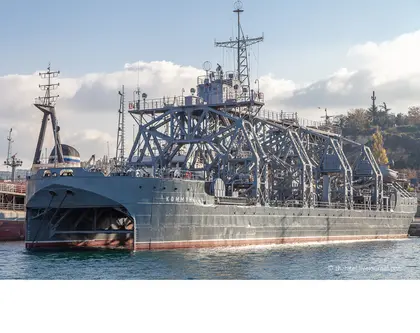A complex chain of Ukrainian air operations and ground strikes around the occupied Crimea peninsula culminated on Saturday with at least one hit by a heavy, long-range anti-ship missile on a Kremlin warship, putting the oldest vessel in the entire Russian navy out of action, probably for months.
The rescue ship Kommuna, a vessel built during the Tsarist era and still used by Russia’s Sevastopol-based Black Sea Fleet (BSF) for deep sea rescues and submarine tending, was set afire following multiple explosions during a daylight attack, local news and social media sources said. Some reports said a single missile hit the Kommuna amidships.
JOIN US ON TELEGRAM
Follow our coverage of the war on the @Kyivpost_official.
Ukrainian navy spokesman Dmitro Pletenchuk in a Sunday statement said Kyiv air and naval forces conducted the raid hitting the BSF’s heavily-defended main base. He did not offer details.
Mikhail Razvozhaev, the Kremlin-appointed governor of the Russia-occupied Crimea region, in a Telegram statement widely repeated by major Russian media, including the national news agency Interfax, said falling debris from a missile intercept above Sevastopol port caused minor damage and a fire that was quickly put out.
Ukrainian and Russian media reports said the Kommuna, during the Saturday attack, was damaged by the missile blast and a subsequent severe fire. Open source satellite images showed the ship tied up at wharf number 14 in Sevastopol port. Geo-located video published on local social media and fact-checked by Kyiv Post showed a blaze and billowing smoke in the center of the ship.

Ukrainian Marines Crush Russian Assault, Destroy Armored Vehicles and Infantry
«Ракета въ*бала в пароход. Видишь, горит. Так что у меня сегодня второй день рождения»,
— миллиард казахстанцев (@S8gy2AEgVRHyS2Q) April 21, 2024
— в сети публикуют видео, как утверждается, с горящим после атаки судном в Севастополе. pic.twitter.com/eXMZZ4O4fN
Pletenchuk in Monday’s comments to Radio Svoboda said Russian naval officials had tied the Kommuna up with blocking vessels on either side in an attempt to protect the high-value vessel from missile attack.
Ukrainian strike planners in past attacks on Sevastopol have launched British-made Storm Shadow or French-made Scalp anti-ship missiles, or Ukraine-produced Neptune anti-ship missiles, to hit Russian fleet elements tied up in the port.
Before Saturday, the most recent Ukrainian strike against Kremlin warships in the area took place on March 24, when a Neptune missile plowed into the Russian navy amphibious assault ship Konstantin Olshanskiy, damaging her at her moorings.
According to a Monday report in the military news publication Defense Express, a modernized Neptune missile probably launched from Ukraine’s Kherson region used artificial intelligence to select the Kommuna, the biggest warship currently tied up in Sevastopol harbor.

A hulking, 100-meter-long vessel rigged with multiple cranes and boasting a fighting record stretching back to the First World War, the Kommuna was the modern Russian Black Sea Fleet’s sole vessel capable of deep-water salvage operations.
The Kommuna and her crew led salvage operations following Ukraine’s most spectacular naval victory to date, the April 2022 sinking of the Black Sea Fleet’s then-flagship, the heavy missile cruiser Moskva.

Russia’s two-year-old full-scale invasion of Ukraine has arguably been most unsuccessful at sea, and by some standards, Russia’s naval war in the Black Sea has played out disastrously. Since Russian marine amphibious landings along Ukraine’s southern coast in February 2022, to the present, Ukrainian missiles have sunk one-third of all the BSF’s warships, and more than half of the total tonnage of vessels operated by the BSF at the start of the war.
A secondary mission for the Kommuna had been to load Kaliber cruise missiles aboard Russian submarines based at Sevastopol, for transport into the Black Sea and subsequent launch at Ukrainian homes or businesses. At the start of the full-scale war, the BSF operated five Kaliber-capable submarines based at the port. One sub, the Rosov-na-Danu, was demolished and written off following a pair of anti-ship missile hits on Sept. 13.
The Saturday attack targeting Russian fleet elements in Sevastopol harbor was preceded by a series of Ukrainian air strikes targeting Kremlin air defenses around the air base Dzhankoi, among them powerful S-400 anti-aircraft missile batteries billed by the Kremlin as being able to shoot down any missile or aircraft operated not just by the Ukrainian military, but NATO.
A series of surface-to-surface missile attacks pummeled Russian missile batteries protecting the north Crimea airfield. According to some reports, Kyiv used US-made ATACMS missiles loaded with cluster munitions in the strikes.
Russian air defenses around Dzhankoi form a critical first line in the layered Kremlin airspace watch network built around Russia’s main military hub in Crimea, Sevastopol-based warships and port and air base facilities in the vicinity.

In past missile attacks against Kremlin warships in Sevastopol, Ukrainian strike planners have frequently targeted Russian air defenses first. The strikes against Dzhankoi, reportedly putting at least four Russian S-400 launchers out of action on Thursday, seemed to parallel that tactic, but Pletenchuk did not offer details on attacks preparatory to the Saturday strike on the Kommuna.
Russian mil-bloggers have repeatedly attacked Western nations supporting Ukraine, and particularly the US, for allegedly helping Kyiv attack warships in the Black Sea littoral by flying high-tech reconnaissance aircraft around Kremlin military installations and then passing targeting data to Ukrainian strike planners.
On the day of the strike hitting the Kommuna, the nearest Western military reconnaissance aircraft to Crimea according to open sources was a US Navy Poseidon spy plane that flew a donut-hole pattern for several hours over Romania’s Danube delta region, some 300-320 km west of Sevastopol. The US conducts a Poseidon patrol flight in the area almost daily.

On Sunday, 24 hours after the Sevastopol strike, a US Air Force Global Hawk reconnaissance drone flew into airspace over the Black Sea shortly after midday local time and loitered in the area for more than six hours. Its closest approach to Russia-claimed airspace over Crimea was about 90 km, and to the Russian naval base was about 150 km, data published by the flight traffic tracker FlightRadar24 showed.
Regarding a recent Ukrainian missile attack on the Russian warship Kommuna, the Russian governor of Crimea Razvozhaev said there was no hit to the warship and that there was only minor damage to the ground from falling debris. Fact-checking video showed fires and thick smoke dated to the day of the attack, and geo-located to Sevastopol port, burning in the central portion of the Kommuna’s main deck. These fact checks made clear the Russian official Razvozhaev was either badly informed or lying, what he said did not happen.
You can also highlight the text and press Ctrl + Enter










